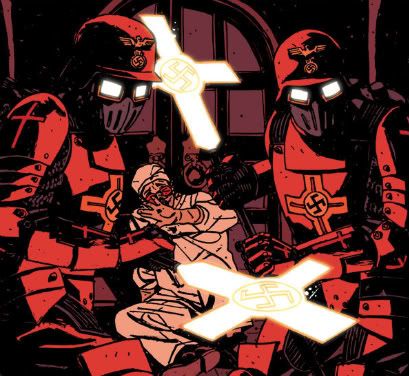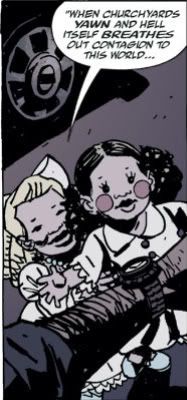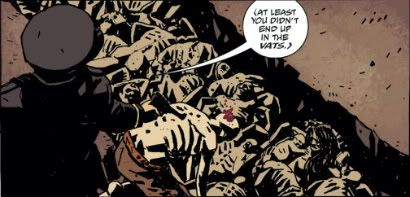Old Black Magic
B.P.R.D.: 1946 #1-5 (of 5)
(or, B.P.R.D. #39-43, if you like)

I've said before that B.P.R.D. is probably the most consistently good ongoing series out there in the Direct Market, and there's little here to shake my resolve, despite the presence of a mostly new creative team, working with a unique set of main characters and providing such a noticeably different overall 'feel' that it almost seems like a totally different title - which, granted, it is, if you only look at the subtitle and issue numbers on the front cover. Credit must go to creator/co-writer Mike Mignola and editor Scott Allie for not only keeping the quality level high, but affording each new piece of the Hellboy jigsaw its own special character.
That's not to say all of it's necessarily superior work; critical reaction to the recent 'character' miniseries has been pretty mixed (although I liked Lobster Johnson: The Iron Prometheus good enough, and haven't started with Abe Sapien: The Drowning), and even B.P.R.D. itself took a few storylines to find its legs.
And, given the differing textures of the Hellboy line, some reactions are perhaps bound to lean on personal preference; for me, the recent Darkness Calls storyline in the main Hellboy book handily reasserted the core title's status as visual spectacle first, planted atop a patchwork mythology that's gotten so big that the narrative now seems preoccupied with sewing together more patches, when it's not in the midst of a three and a half-issue fight scene.
I did enjoy it, mind you. The story lays itself out with terrific panache, Mignola's idiosyncratic plotting is bouncy as ever (I love his way of building up characters as massive threats, only to bump them aside in favor of unexpected, possibly improvised developments), and artist Duncan Fegredo is just as fine as we all expected. And I'll readily admit that, for some, admiring Mignola's mustering of diverse world mythology into a cohesive fight comic schema is its own pleasure, maybe an overriding one.
But dammit, I like B.P.R.D. more. It's a more constrained series, despite its large cast, and keenly focused on personal questions of identity and mortality that tend to get drowned under the thunder of Hellboy proper. It's a more writerly series, but with no loss of visual appeal; regular artist Guy Davis can work the grotesque like almost nobody else in front-of-Previews comics, but the delicacy he brings to his character art compliments each set of philosophical troubles Mignola and co-writer John Arcudi present their cast, fresh ones every storyline. All in the form of superior action/horror pop comics, with hardly a jolt in its arrow-straight continuity.
Well, until now.

As the title suggests, 1946 is set in the past; it follows the adventures of Hellboy's 'father,' Prof. Trevor Bruttenholm, as he investigates the many weird things the Nazis were up to when they weren't bringing a certain lil' devil to Earth. This particular plot serves to flesh out a throwaway concept from the early Hellboy storyline Wake the Devil: Project Vampir Sturm, an ill-fated Nazi attempt at forming an alliance with Count Vladimir Giurescu, a notorious blood-sucker.
Giurescu is still a player in the main Hellboy book (he popped up in Darkness Calls), and another popular face from the wider Mignola mythos turns in a key appearance -- seriously, this stuff is as friendly to completists as Alan Moore's ABC line at Wildstorm -- but 1946 is mainly focused on Bruttenholm's uneasy investigation of the project's terrible aftermath, including a frequent give-and-take with Varvara, a callous, white-clad little girl who's Head of Arcane Studies and Esoteric Teachings for the USSR. Wholly interested in amusement and novelty, and wielder of the impossible Hell power of Little Dolly Katiya -- so impossible that we never actually see it used in-panel, maybe because the very sight would drive us mad!! -- she's Bruttenholm's demonic opposite in every way, and likely the unique antagonist of this wing of B.P.R.D., should future stories develop.
(although this is a Hellboy family book, so I guess she could have appeared in the background of one panel from a short story back in 1998 or something)
The new contributers to this story are co-writer Joshua Dysart (previously of various licensed books at Dark Horse), penciller/inker Paul Azaceta and colorist Nick Filardi (both of the Image series Grounded). I was impressed by how Azaceta, even through his thick outlines, managed to preserve some of the gentleness of body that Davis typically brings. His characters look outwardly stolid yet somehow easy to hurt, and Filardi's dim, drained colors ensure that world looks always ready to hurt them, with sudden blasts of red, green and blue marking moments of overt violence. As a work of the past, it has a mournful quality.
Dysart and Mignola certainly follow through on that - while all of the Hellboy books are at least nominally 'horror' comics, this is the most purely horrific of all of them, in that it deals specifically with the atrocious implications of those ever-familiar Nazi villains, linking the pulpy nature of sci-fi stuff with the truth of human experimentation. It's far darker than Mignola typically goes; glimpses of Hellboy's oncoming apocalypse krackles with Kirby, while the characteristic battles of the B.P.R.D. zoom in on the softness of the individual's flesh.
Not here; Bruttenholm uncovers systemic, forced transformations, and a bravura mid-story set piece sees Allied soldiers of every stripe losing their shit epically at the hands of the half-there ghosts of the past. And pint-sized Varvara emerges as not so much wicked for her deeds, but for devouring it all as simple, jolly fun ("Little Dolly Katiya thinks your ethical sensitivity is silly."). Could this be some type of... unease over the Hellboy line's frequent darting into historical brutality?

It's a line that must be toed with care, and the story does wobble a little as it approaches its finish. I don't know how much Mignola directly contributed to this story -- he can be an extremely assertive writer, sometimes going so far as to provide thumbnails for his artists to follow, although he also tends to give artists like Davis greater leeway -- but its endgame bears what strikes me as 'his' stamp, in that the narrative dissolves into a breakneck action scene from which the main character eventually stumbles out of, only to exchange words with some other character so as to wrap up some (not all) loose ends. This particular slam-bang finale even rolls out some of the franchise's goofiest villain types, which threatens to render the whole thing tonally disjointed in the ugliest way.
That doesn't happen, in that the creative team has done enough work that the sight of an enormous, half-metal half-meat giraffe is more disturbing than anything. A crazed fatalism hangs over the whole climax, even as things explode and villains rant. In the end, the only hope left is that the world's monsters can hold a capacity for kindness, even as its sweet little girls might be demons inside.
Don't ask me to guess how this brand of storytelling might sustain itself over multiple adventures -- nothing further has been yet announced -- but what it does here is demonstrate once again the pliability of Mignola's concept, and a willingness to delve into even the hurtful background of campy doctors and strange beasts. Not bad for an extended reflection on secret origins.
(or, B.P.R.D. #39-43, if you like)

I've said before that B.P.R.D. is probably the most consistently good ongoing series out there in the Direct Market, and there's little here to shake my resolve, despite the presence of a mostly new creative team, working with a unique set of main characters and providing such a noticeably different overall 'feel' that it almost seems like a totally different title - which, granted, it is, if you only look at the subtitle and issue numbers on the front cover. Credit must go to creator/co-writer Mike Mignola and editor Scott Allie for not only keeping the quality level high, but affording each new piece of the Hellboy jigsaw its own special character.
That's not to say all of it's necessarily superior work; critical reaction to the recent 'character' miniseries has been pretty mixed (although I liked Lobster Johnson: The Iron Prometheus good enough, and haven't started with Abe Sapien: The Drowning), and even B.P.R.D. itself took a few storylines to find its legs.
And, given the differing textures of the Hellboy line, some reactions are perhaps bound to lean on personal preference; for me, the recent Darkness Calls storyline in the main Hellboy book handily reasserted the core title's status as visual spectacle first, planted atop a patchwork mythology that's gotten so big that the narrative now seems preoccupied with sewing together more patches, when it's not in the midst of a three and a half-issue fight scene.
I did enjoy it, mind you. The story lays itself out with terrific panache, Mignola's idiosyncratic plotting is bouncy as ever (I love his way of building up characters as massive threats, only to bump them aside in favor of unexpected, possibly improvised developments), and artist Duncan Fegredo is just as fine as we all expected. And I'll readily admit that, for some, admiring Mignola's mustering of diverse world mythology into a cohesive fight comic schema is its own pleasure, maybe an overriding one.
But dammit, I like B.P.R.D. more. It's a more constrained series, despite its large cast, and keenly focused on personal questions of identity and mortality that tend to get drowned under the thunder of Hellboy proper. It's a more writerly series, but with no loss of visual appeal; regular artist Guy Davis can work the grotesque like almost nobody else in front-of-Previews comics, but the delicacy he brings to his character art compliments each set of philosophical troubles Mignola and co-writer John Arcudi present their cast, fresh ones every storyline. All in the form of superior action/horror pop comics, with hardly a jolt in its arrow-straight continuity.
Well, until now.

As the title suggests, 1946 is set in the past; it follows the adventures of Hellboy's 'father,' Prof. Trevor Bruttenholm, as he investigates the many weird things the Nazis were up to when they weren't bringing a certain lil' devil to Earth. This particular plot serves to flesh out a throwaway concept from the early Hellboy storyline Wake the Devil: Project Vampir Sturm, an ill-fated Nazi attempt at forming an alliance with Count Vladimir Giurescu, a notorious blood-sucker.
Giurescu is still a player in the main Hellboy book (he popped up in Darkness Calls), and another popular face from the wider Mignola mythos turns in a key appearance -- seriously, this stuff is as friendly to completists as Alan Moore's ABC line at Wildstorm -- but 1946 is mainly focused on Bruttenholm's uneasy investigation of the project's terrible aftermath, including a frequent give-and-take with Varvara, a callous, white-clad little girl who's Head of Arcane Studies and Esoteric Teachings for the USSR. Wholly interested in amusement and novelty, and wielder of the impossible Hell power of Little Dolly Katiya -- so impossible that we never actually see it used in-panel, maybe because the very sight would drive us mad!! -- she's Bruttenholm's demonic opposite in every way, and likely the unique antagonist of this wing of B.P.R.D., should future stories develop.
(although this is a Hellboy family book, so I guess she could have appeared in the background of one panel from a short story back in 1998 or something)
The new contributers to this story are co-writer Joshua Dysart (previously of various licensed books at Dark Horse), penciller/inker Paul Azaceta and colorist Nick Filardi (both of the Image series Grounded). I was impressed by how Azaceta, even through his thick outlines, managed to preserve some of the gentleness of body that Davis typically brings. His characters look outwardly stolid yet somehow easy to hurt, and Filardi's dim, drained colors ensure that world looks always ready to hurt them, with sudden blasts of red, green and blue marking moments of overt violence. As a work of the past, it has a mournful quality.
Dysart and Mignola certainly follow through on that - while all of the Hellboy books are at least nominally 'horror' comics, this is the most purely horrific of all of them, in that it deals specifically with the atrocious implications of those ever-familiar Nazi villains, linking the pulpy nature of sci-fi stuff with the truth of human experimentation. It's far darker than Mignola typically goes; glimpses of Hellboy's oncoming apocalypse krackles with Kirby, while the characteristic battles of the B.P.R.D. zoom in on the softness of the individual's flesh.
Not here; Bruttenholm uncovers systemic, forced transformations, and a bravura mid-story set piece sees Allied soldiers of every stripe losing their shit epically at the hands of the half-there ghosts of the past. And pint-sized Varvara emerges as not so much wicked for her deeds, but for devouring it all as simple, jolly fun ("Little Dolly Katiya thinks your ethical sensitivity is silly."). Could this be some type of... unease over the Hellboy line's frequent darting into historical brutality?

It's a line that must be toed with care, and the story does wobble a little as it approaches its finish. I don't know how much Mignola directly contributed to this story -- he can be an extremely assertive writer, sometimes going so far as to provide thumbnails for his artists to follow, although he also tends to give artists like Davis greater leeway -- but its endgame bears what strikes me as 'his' stamp, in that the narrative dissolves into a breakneck action scene from which the main character eventually stumbles out of, only to exchange words with some other character so as to wrap up some (not all) loose ends. This particular slam-bang finale even rolls out some of the franchise's goofiest villain types, which threatens to render the whole thing tonally disjointed in the ugliest way.
That doesn't happen, in that the creative team has done enough work that the sight of an enormous, half-metal half-meat giraffe is more disturbing than anything. A crazed fatalism hangs over the whole climax, even as things explode and villains rant. In the end, the only hope left is that the world's monsters can hold a capacity for kindness, even as its sweet little girls might be demons inside.
Don't ask me to guess how this brand of storytelling might sustain itself over multiple adventures -- nothing further has been yet announced -- but what it does here is demonstrate once again the pliability of Mignola's concept, and a willingness to delve into even the hurtful background of campy doctors and strange beasts. Not bad for an extended reflection on secret origins.

<< Home